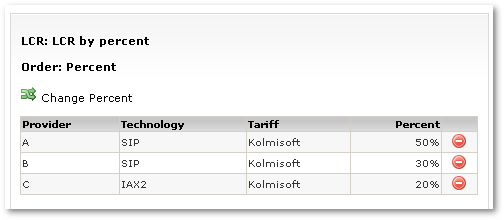Difference between revisions of "Routing by Percent"
| Line 1: | Line 1: | ||
<!---This functionality is available from MOR 8---> | |||
This type of routing selects a route by percentage value of Providers. | This type of routing selects a route by percentage value of Providers. | ||
It is similar to Priority-based routing, except that here Providers are selected randomly with greater or lesser probability. | It is similar to Priority-based routing, except that here Providers are selected randomly with greater or lesser probability. | ||
<br><br> | |||
[[Image:route_by_percent.png]] | [[Image:route_by_percent.png]] | ||
<br><br> | |||
== Example 1 == | == Example 1 == | ||
| Line 43: | Line 40: | ||
So we can get various results, such as A-B-C, A-C-B, B-A-C, C-A-B etc. BUT, following mathematical reasoning, when we make a huge amount of tries (going till infinity), sets will follow the rule in the first step: the Provider selected first will be A in 50% of the cases, B in 30%, and C in 20%. | So we can get various results, such as A-B-C, A-C-B, B-A-C, C-A-B etc. BUT, following mathematical reasoning, when we make a huge amount of tries (going till infinity), sets will follow the rule in the first step: the Provider selected first will be A in 50% of the cases, B in 30%, and C in 20%. | ||
<br><br> | |||
== Example 2 == | == Example 2 == | ||
| Line 57: | Line 53: | ||
The probability that the provider order will be B-A is just 1%. | The probability that the provider order will be B-A is just 1%. | ||
<br><br> | |||
== Fail-over == | == Fail-over == | ||
Revision as of 13:16, 1 March 2013
This type of routing selects a route by percentage value of Providers.
It is similar to Priority-based routing, except that here Providers are selected randomly with greater or lesser probability.

Example 1
For example, we have three providers with the following preferences:
A - 50% B - 30% C - 20%
This means that:
- Provider A will be chosen FIRST with 50% probability.
- Provider B will be chosen FIRST with 30% probability.
- Provider C will be chosen FIRST with 20% probability.
MOR orders these providers using the following algorithm:
As a first step, it randomly selects the first provider. There is a 50% chance that Provider A will be selected, 30% for B, and 20% for C.
Lets say the randomly selected Provider is B.
At the second step, MOR selects from the remaining providers:
A - 50% C - 20%
There is a much greater chance that A will be randomly selected than C. So let's say A is selected.
The final order of our providers will be:
B - A - C
Every time, the order is RANDOMLY done in the same way, using percent values for probability.
So we can get various results, such as A-B-C, A-C-B, B-A-C, C-A-B etc. BUT, following mathematical reasoning, when we make a huge amount of tries (going till infinity), sets will follow the rule in the first step: the Provider selected first will be A in 50% of the cases, B in 30%, and C in 20%.
Example 2
To better illustrate the method, let's take a simpler situation. We have two providers with these percentages:
A - 99% B - 1%
Provider A will be selected first 99% of the time, so that when we have many ordered lists, they will look like:
A-B, A-B, A-B, A-B, A-B, ........., B-A, A-B,........A-B, ..........
The probability that the provider order will be B-A is just 1%.
Fail-over
This LCR ordering still keeps Fail-Over intact.
That is, after we have ordered the provider list, if the first provider in the list fails, the second will be dialed and so on.
